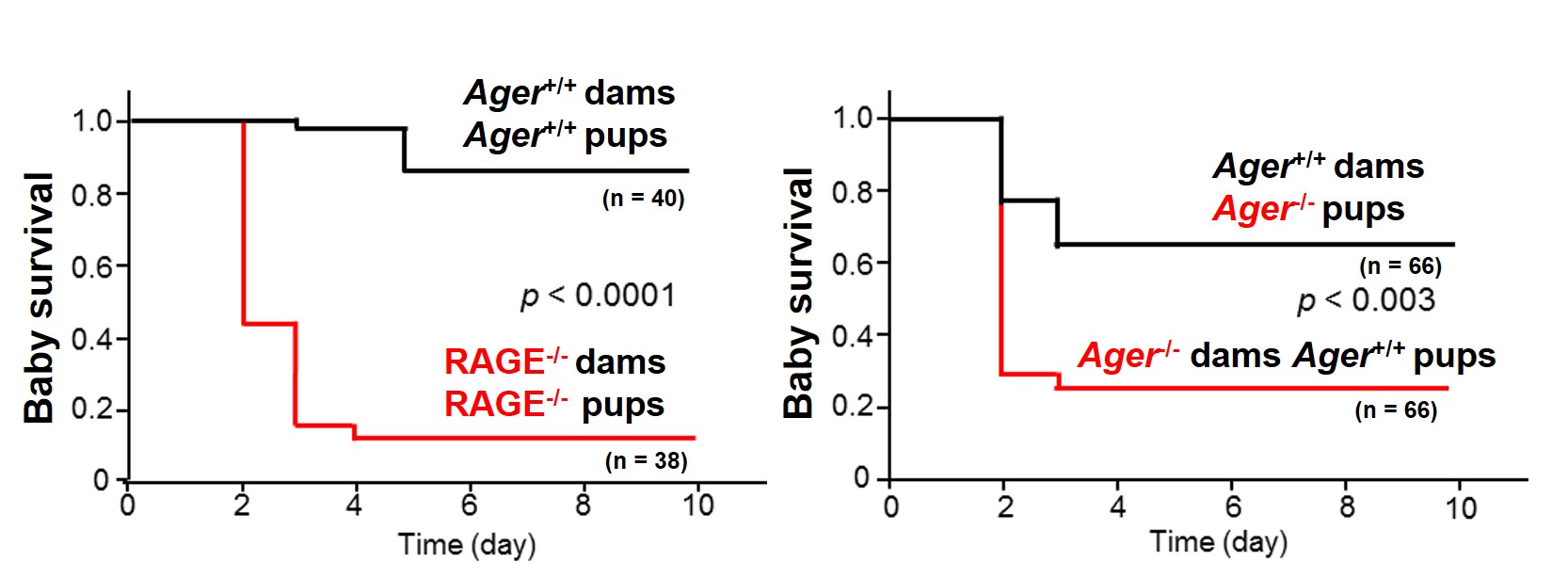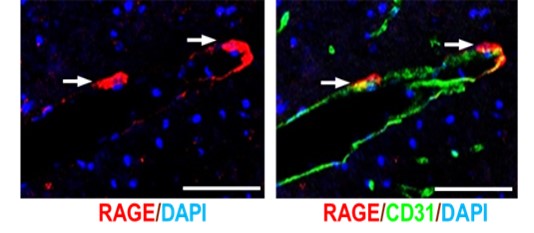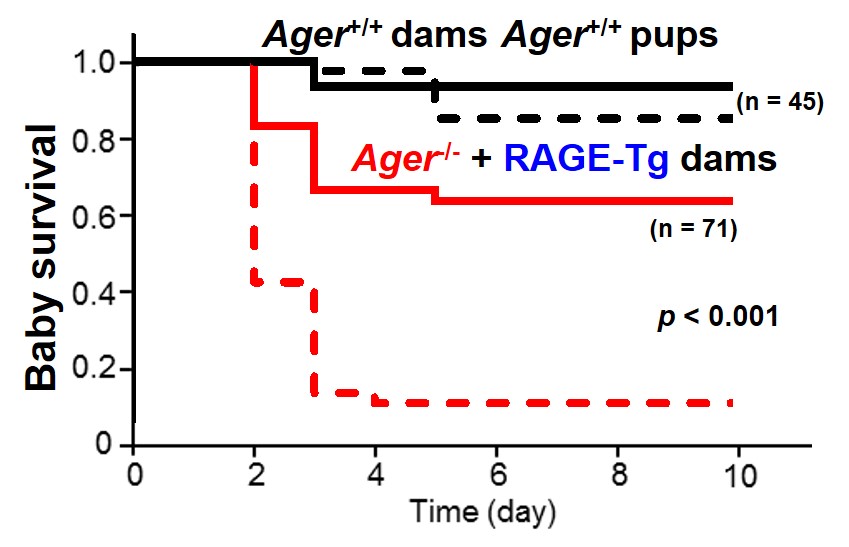Abstract:
Oxytocin is essential in activities of the social brain such as trust and love and in maternal bonding behaviors. It is produced in the brain and secreted into the circulation. Here, by analyzing maternal behaviors of RAGE gene-manipulated mice, oxytocin was found to be transported back to the brain, crossing the blood-brain barrier (BBB), an extremely effective barrier, by binding to the receptor for advanced glycation end-products (RAGE) on capillary endothelial cells of the BBB.
[Background]
Oxytocin*1) is a cyclic peptide consisting of 9 amino acid residues. Oxytocin is primarily produced by the neurosecretory cells in paraventricular hypothalamic and supraoptic nuclei and released from the nerve endings of the posterior pituitary into the circulation. Its peripheral effects include uterine contractions upon induction of labor pains and initiation of lactation. Recently, it has been known that oxytocin is involved in central actions upon regions of the ‘social brain’ such as the amygdala and the hypothalamus, important in the formation of trust and love. The most basic unit needing trust and love is the parent-child relationship, especially maternal bonding behaviors. Child rearing is a social behavior not restricted to humans but also seen in the mouse; the maternal nurturing behaviors serve to enhance the survival rate of offspring.
In order for oxytocin to exert its central nervous system effects to elicit social behaviors, it must enter the central nervous system from the peripheral circulation, crossing the blood-brain barrier (BBB)*2). However, the existence of such translocation and its potential molecular mechanisms were unknown.
[Outline of research results]
A Kanazawa University multidisciplinary research group, who led the present study as the core of an international research team with scientists from two domestic universities, Kanazawa Medical University and Tohoku University, as well as from Krasnoyarsk State Medical University, Russia, and Harvard Medical School, US, has been focusing its research on the protein molecule, RAGE (Receptor for Advanced Glycation End-products)*3), by generating and analyzing RAGE overexpressing transgenic mice (RAGE-Tg) and, especially, RAGE knockout mice (RAGE-KO). RAGE was first discovered as a cell membrane receptor of advanced glycation end-products, AGE, which is produced by a glycation reaction. However, RAGE is now considered to be a member of the class of pattern recognition receptors involved in innate immunity such as the Toll-like receptors. RAGE is thought to be causatively involved in a variety of illnesses.
When females from a colony of homozygous RAGE-KO mice experienced environmental stress, such as when being transferred to a new mouse cage, we observed that the survival rate of their offspring was significantly reduced (Figure 1 left). To confirm this observation, RAGE-KO baby mice were replaced with wild-type baby mice. We found that the survival rate of the wild-type baby mice nurtured by homozygous RAGE-KO mother mice was significantly lower than those nurtured by wild-type mother mice (Figure 1 right). Such abnormal maternal nurturing behaviors of mother mice were observed with oxytocin KO mice, oxytocin receptor KO mice and CD38-KO mice, which show a reduction in oxytocin secretion (Takayanagi Y. et al. PNAS 2005, Jin D. et al. Nature 2007). Thus it was hypothesized that RAGE-KO mother mice should show an abnormality in maternal nurturing behaviors in which oxytocin is involved.
The research team investigated directly the binding of synthetic oxytocin to purified recombinant human and mouse RAGE proteins using surface plasmon resonance and plate assays. It was confirmed that oxytocin bound to two (V domain and C1 domain) of three immunoglobulin-like domains (from the N-terminus, V, C1 and C2) of the extracellular part of the RAGE protein. Next, oxytocin transport through the BBB was assessed using a BBB transport assay kit (MBT-24H, PharmaCo-Cell) in vitro, which consists of capillary vascular units constructed with primary cultures of monkey brain capillary endothelial cells coupled with rat pericytes and astrocytes. RAGE expression in the capillary endothelial cells used in this experiment was confirmed and RAGE-dependence was assessed by a knockdown experiment using RAGE shRNA vector (pSilencer 3.0-H1 vector (Ambion)) that inhibits RAGE expression and its control vector. By employing transendothelial electrical resistance (TEER), which reflects the Na ion flow through cell layers, as an index, the tightness of the BBB was confirmed throughout the experiment. This experiment indicated that oxytocin transport to the brain side chamber was detected only when oxytocin was added to the blood side chamber, whereas brain-to-blood oxytocin transport was not detected at all. Apparent permeability of oxytocin was RAGE dependent, around 3.0 x 10-6 cm/s, which is the same order of permeability of drugs that can barely enter the brain. It was considered that for transport, activation of the intracellular RAGE signaling system was not necessary.
These results suggested that RAGE bound oxytocin and mediated oxytocin transfer through the BBB and its transport to the central nervous system. RAGE expression on capillary endothelial cells in the mouse brain was confirmed (Figure 2). Then, oxytocin transport to the brain was confirmed by administering synthetic oxytocin (with natural isotopes or with 13C and 15N) to mice by subcutaneous injection, intravenous injection and intranasally. The time course indicated that in RAGE-KO mice, transport was detected neither to the cerebrospinal fluid nor to the brain, contrary to the results with wild-type mice. When rescue experiments for nurturing behaviors were performed by adding RAGE back into the capillary endothelial cells of RAGE-KO mother mice showing abnormal nuturing behaviors, the survival rate of baby mice was significantly augmented (Figure 3). For confirmation, oxytocin transport to the brain was assessed and revealed that oxytocin was transported into the brain in RAGE-KO mice that had had RAGE re-added into their capillary endothelial cells.
Our study showed that oxytocin synthesized in the brain and secreted into the circulation binds to RAGE molecules on capillary endothelial cells, a component of the BBB, and is transported into the brain. By being transported into the brain, oxytocin exerts central nervous functions.
[Future prospects]
This study reveals that RAGE is an essential molecule existing at the BBB for oxytocin transport into the brain and as a basis for oxytocin functions in maternal bonding and nurturing. The results should lead to the development of new therapeutic methods for mental disorders like schizophrenia and reactive attachment disorder, including autism spectrum disorder. The present team is deeply engaged in research that might contribute to solving growing social problems in this declining birthrate era such as child neglect and abuse.

Figure 1. Survival of baby mice nurtured by homozygous RAGE-KO mother mice.
Left, baby mice not replaced: Right, baby mice replaced with wild type.
A relationship is observed between RAGE and nurturing behaviors of mother mice. Survival rate of baby mice of RAGE-KO mother mice is low (left). With wild type baby mice, survival rate is still low (right).

Figure 2. Expression of RAGE in the brain vascular endothelial cells of the hippocampus.
RAGE is expressed in the brain vascular endothelial cells (indicated with arrows). CD31 is a marker protein of vascular endothelial cells.

Figure 3. Relationship between RAGE in the brain vascular endothelial cells and nurturing behaviors of mice.
It is clearly shown that by RAGE replacement in brain vascular endothelial cells of RAGE-KO mother mice by gene manipulation, the survival rate of baby mice was statistically significantly increased.
[Glossary]
*1) Oxytocin
Oxytocin is a peptide hormone released by the posterior pituitary. Oxytocin is thought to play important roles in maternal behaviors, social bonding such as building up human relations, relieving anxiety, etc.
*2) Blood-brain barrier
The blood-brain barrier (BBB) is formed mostly by endothelial cells and plays a role in regulating the passage of materials between the circulating blood and the central nervous system. Nutrients for the brain such as glucose and amino acids are actively taken up into the central nervous system while the BBB plays a role as an effective barrier against drugs and foreign substances.
*3) RAGE
RAGE is a receptor protein to bind advanced glycation end-products, AGE, produced by glycation related to ageing. RAGE is causatively involved in inflammation and in the pathogenesis and progression of aging-related diseases (diabetes, arteriosclerosis, cancer metastasis, pulmonary fibrosis, etc.). Since it is involved in various natural diseases, it is classified as a member of the class of pattern-recognition receptors.
Article
Vascular RAGE transports oxytocin into the brain to elicit its maternal bonding behaviour in mice
Journal: Communications Biology
Authors: Yasuhiko YAMAMOTO, Mingkun LIANG, Seiichi MUNESUE, Kisaburo DEGUCHI, Ai HARASHIMA, Kazumi FURUHARA, Teruko YUHI, Jing ZHONG, Shirin AKTHER, Hisanori GOTO, Yuya EGUCHI, Yasuko KITAO, Osamu HORI, Yoshitake SHRAISHI, Noriyuki OZAKI, Yu SHIMIZU, Tomoya KAMIDE, Akifumi YOSHIKAWA, Yasuhiko HAYASHI, Mitsutoshi NAKADA, Olga LOPATINA, Maria GERASIMENKO, Yulia KOMLEVA, Natalia MALINOVSKAYA, Alla B. SALMINA, Masahide ASANO, Katsuhiko NISHIMORI, Steven E. SHOELSON, Hiroshi YAMAMOTO, and Haruhiro HIGASHIDA
DOI: 10.1038/s42003-019-0325-6
Funder
Kanazawa University SAKIGAKE project 2018, AMED Strategic Research Program for Brain Sciences, JSPS KAKENHI (24590375, 25461335 and 18K06889), JSPS Programme for Fostering Globally Talented Researchers (S2901).



 PAGE TOP
PAGE TOP